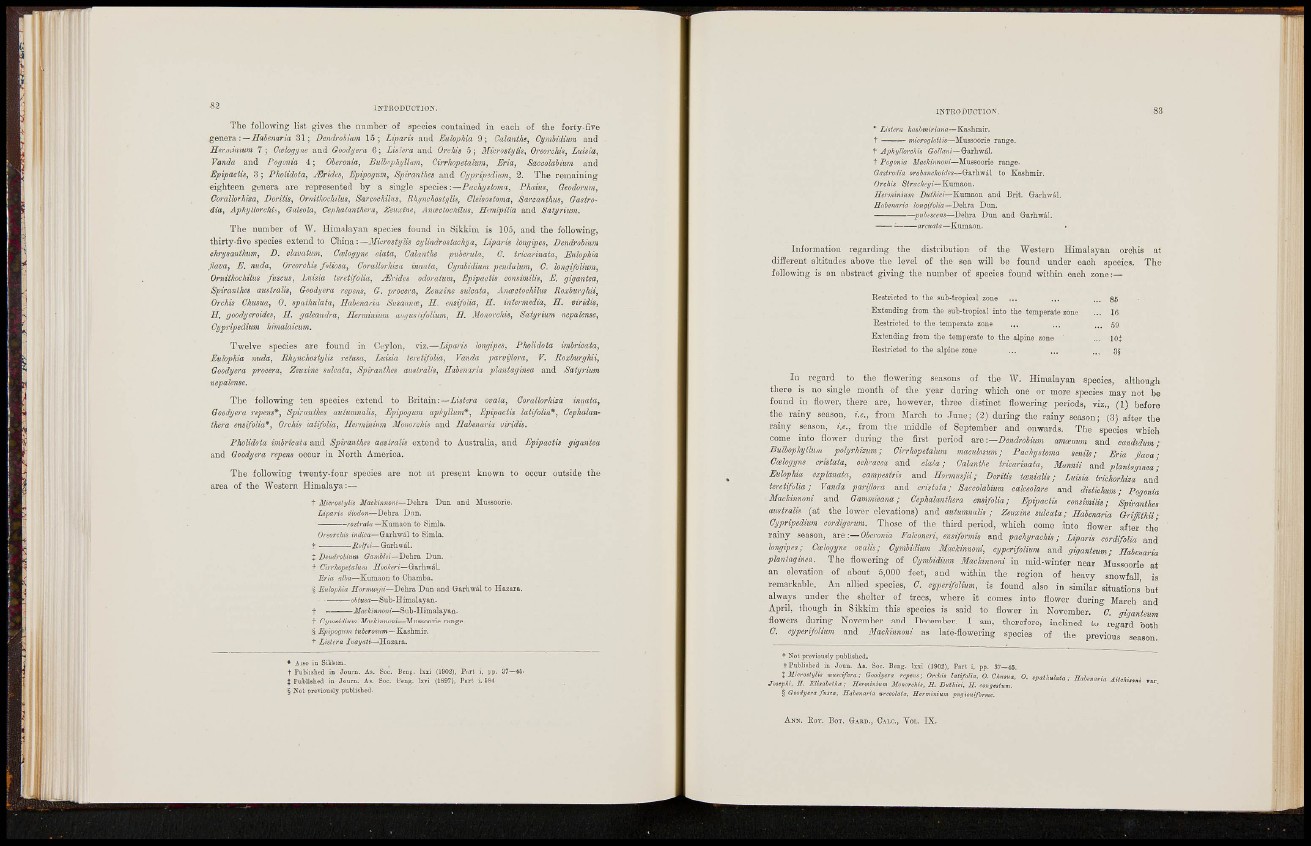
82 INTRODUCTION.
The following list gives the number of species contained in each of the forty-five
genera:—^aienarw 31; Dcndrobiam 15; Liparis and Eulopkia 9; Calanthe, Cymbidimi and
Senuinium 7; Cce logy ne and Goody era 6; Liòiera and Orchis 5] Aficrosii/its, Oreorchi«, Luisia,
Vanda and Pogonia i ; Gberonia, Eulbrphyllam, Cirrhopetalum, Eria, Saccolalium and
Epipaciis, 3 ; PhoUdota, brides, Epipogutn, Spiranthes and Cypripsdhim, 3. The remaining
eighteen genera are represented by a single species Phums, Geodonun,
Corallorkisa, Doriiis, Orniikoùlùlus, Sarcnckilns, Rhiinchostiilis, Clemstoma, Sarcanthus, Gasirodia,
Aphyllorchi^, Galeola, Cephalanthera, Zeuxine, Anceciochilus, Ilrmipilia and Satyrum.
The number of W. HiinaJayan species found in Sikkim is 105, and the following,
thirty-five species extend to C h i n a o y l i n d r o s t a c h y a , Liparis longipes, Bendrohium
chrysanthm, D. cluvatum, Ccelogyne eiata^ Calanthe pubcruln, 0. triaarinata, Bulophia
flava, E. nuda, Oreorchis foHosa, Corallorhisa innata, Cymhidium pendalum, G. longifoUum,
Orniihochilus fuacus, Luisia tcretlfoKa, jErides odoraliim, Epipactis eonsiinilis, E. gigantea,
Spiranthes australis, Goodyera repeiis, G. procera, Zeiuine sulcata, Anactoahilm RoMburykii^
Orchis Chusua, 0. spai/iulata, Eabenaria Susanncs, M. cnsifolia, H. intenntdia, H. viridis,
il. goodyeraides, H. galeandra, JLerminiiim aiH]Usnfolium, B. Moaorehis, Satyrium nepalense,
Cypripedium himalaicum.
Twelve species are found in Ceylon, TÌZ.—Liparis longipes, PhoUdota imbricata,
Eulophia nuda, Rhynchostylis retuaa, Luisia teretifolia, Vanda parvifiora, V. Roxiurghii,
Goodyera procera, Zeuxine sulcata, Spiranthes aiistralis, Haben%ria plantaginea and Satyrium
The following tea species extend to Britain i—iisfom ovaia, Corallorhisa innata,
Goodyera repcns*, Spiranthes aulumnalis, Epipogam aphyllim*, Epipactis latifolia*, Cephalan'
thera ensifolia*, Orchis latifolia, Ilerminium Jionorchis and Jlahenaria viridis.
PhoUdota imbricata and Spiranthes aiisiralis extend to Australia, and Epipactis gigantea
and Goodyera repens occur in North America.
The following twenty-fom' species are not at present known to occur outside the
area of the West-ern Himalaya:—
t Microsl!/iis MacMivioni—Dehxa DUE and Mussoorie.
Liparii diodun-~Dehiii Dun.
rostrata —Xumaon to Simla.
Oreorchis ¿»¿ica—Garb-wàl to Simla.
+ iii///tf—Garhwal.
; Dendrobitm Gamblei—DahtB. Dua.
+ Cirrhopeialum .fftioieri—Garhwal.
Erlti Kumaon to Chamba.
§ Eulophia Rormmjti—Delira Dun and earhwàl to Hazaro.
—Sul) - H imalayan.
t JIIaciiiH'wni—Sub-IJimalayec.
t Cymoidium Mnckimwni—Mussoorie range.
§ Epipogiim luberomm—Kashmir.
+ Listerà Ji<ajnii—Hazara.
+ Published in Jouro. As. Soo. Betn;. Ixxi (1902), Pun i, pp. 37-
Î PubUshed in Journ. As. Soc. teng. IXTÌ (1897), Puri i. 684
§ Not preTÌously published.
INTRODUCTION-
* Lktera kashr.
- microghtlis—Mussoorie range.
t Aphyllorchii GoUan%--Q<ir\m&\.
t Pogonia ilackinnoni—Mussoorie range.
Gastro-.iia oroisiicAoirffi-v—Gartwal to Kashmir.
Orchis Kumaon.
Herminiuin Luthioi—Elumaou and Brit, Garliwil.
Enhenario. longifolia—T^^Vta. Dun.
piibescens—Debra Dun and Garliwal.
nrcuatii—Kumaon.
Information regarding the distribution of the Western Himalayan orchis at
different altitudes above the level of the sea will be found under each species. The
following is an abstract giving the cumber of species found within each zone:—
Eestrieted to (he sub-tropical zone
Estending from the sub-tropical into the t
Restrioted to tbe temperate zone ...
Estending from the temperate to the alpine zona
Eestrieted to the alpine zone
85
In regard to the flowering seasons of the W. Himalayan species, although
there is no single month of the year during which one or more species may not be
found in flower, there are, however, three distinct flowering periods, viz., (1) before
the rainy season, i.e., from March to June: (2) during the rainy season; (3) after the
rainy season, i.e., from the middle of September and onwards. The species which
come into flower during the first period ave-.—Dendrobium amoenuvi and candidum
Bulbophylluin polyrhiziim; Cirrhopetalum maculosttm ; P achy stoma senile; Eria flava
Ccelogyne cristata, och-aeea iind elaia ; Calanthe tricarinata, -Munnii ¿-yà plantagznea
Eulophia explanata, campestris and Rormusjii; Doritis toenialis ; Luisia trichorhiza and
ieretifolia; Vanda parifiora and cristata; Saccolabium calceolare and distiohum • Pogonia
MacUnnoni and Gaminieana ; Cephalanthera ensifolia; Epipactis consimilis; 'spiranthes
aiistralis (at the lower elevations) autumnalis ; Zeuxine sulcata; Ilahenaria Griffithii-
Cypripedium cordigermn. Those of the third period, which come into flower after thé
rainy season, 9.V6-.—Obcronia Palconen, ensiformis and pachyrachis ; Liparis cordifolia and
longipes; Coelogyne ovalis; Cymbidium Mackinnoni, ajperifoUuni and giganfeum; Sabmaria
plantaginea. The iiowering of Cymhidiimi Mackinnoni in mid-winter near Mussoorie at
an elevation of about 5,000 feet, and within the region of heavy snowfaU is
remarkable. An allied species, C. cyperi/olium, is found also in similar situations' but
always under the shelter of trees, where it comes into flower during March and
April, though in Sikkim this species is said to flower in November. C. giganteum
flowers during November and December. I am, therefore, inclined to regard both
C. cTjperifoUum and Mackinnoni as late-flowering species of the previous season
* Not pi'cTiousîy publisliod.
tPuhlishod in Joau, .Vs. Soc. Beng, Irti (1902), Part i, pp. 37—46,
tMhroUylU mn^cifera; Goodyera rcpe>,s; Oychh latifolia. O. Ckusua. 0. spat Mata ; Sabcnaria AiM,i...i ,
n. Honmnmm Monorchh. E. B«thiei, S. conge,tnm. ^"W"«'"«« ,
§ Goodyera fvsra, Halenaria urceolata. Hcrmiaium pugioniforme.
ANN. EOY. BOÏ. G.MID., C.I.LC., VOL. I X.